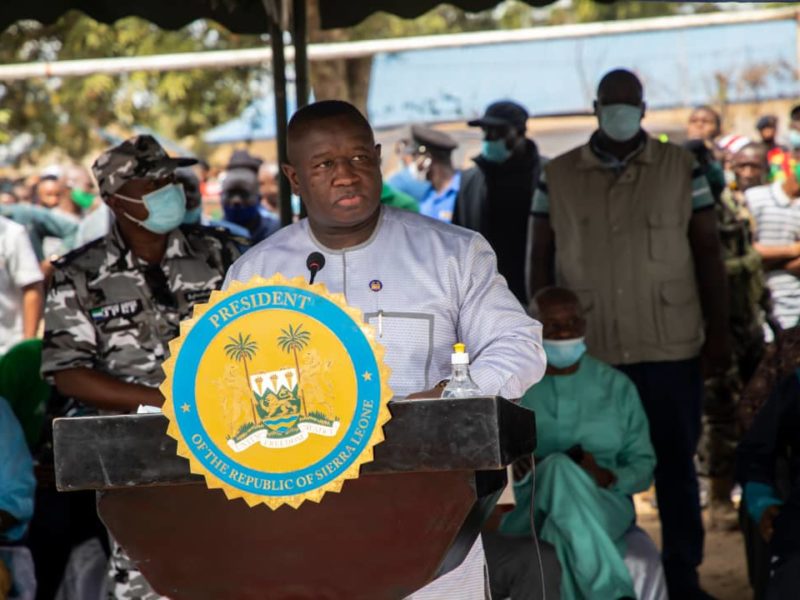Industrializing Agriculture in Sierra Leone – Part One
All over the world, agriculture undeniably provides significant opportunities for investment, jobs, revenue collections and economic growth. In the United States of America (USA) the government relies on agriculture for the creation of jobs and the reduction of their deficits. Such is reflective in the words of Tiffany Shedd a cotton farmer from Penal County in Arizona, “farming is often treated like a hobby – it is not a hobby – it is an industry. Cotton farmers bring USD$ 500,000 per square mile into Penal County’s economy. Agriculture money is the basis for rural American communities”
Treating agriculture like a hobby could best describe Sierra Leone’s farming system. Even though about 75% of our people are farmers yet a little over 80% of these farmers treat agriculture like a hobby, a significant reason why productivity is low and an overwhelming portion of our people are absolutely poor.
Industrializing agriculture will particularly increase our Gross Domestic Product (GDP), create jobs, make us food sufficient, provide feed for our livestock, sustain our forest need, reduce carbon emission and help our vulnerable people adapt to climate change.
Before proffering ways through which we can industrialize agriculture it is important that I lay bare the current status of agriculture in Sierra Leone, government’s recent effort in improving the situation, challenges and deficiencies in government’s current strategy and then what we MUST do to get the desired results and show the world that despite our horrific past our national resolve is sufficient to give back to us our once buoyant economy and redeem our global status.
Current Status of Agriculture
Agriculture in Sierra Leone is a crucial economic activity providing employment for over 80% of Sierra Leoneans and in relative terms immensely contributing to the livelihood of those engaged in it. But the irony is that presently only 2% of our arable land (land capable of producing crops) is being uncultivated. This shows our present agricultural engagement is insignificant as compared to our nation’s natural land endowments and that there is enormous potential that lays there untapped.
Our beloved Sierra Leone is endowed with huge fertile land and favourable weather. Sierra Leone has a tropical weather system with different types of soil that is conducive for the planting of not only all of our food stuff but also those commodities crops that sell mostly on international stock markets, for example soybeans, wheat, corn, maize, sugar, coffee, cocoa, rubber, lumber, grape and the like.
Sierra Leone is endowed with all types of soil, loamy which has sand, clay, and silt and is the most favourable for farming. Silty soil which is a granular like sandy soil but has more nutrients,it is sticky when moistened. Clay soil which has less air space and it is very heavy when wet, and organic fertilizer is normally needed. Sandy soil which is gritty in texture and is formed by the disintegration and weathering of rocks. Peaty soil which is formed by the accumulation of dead and decomposed organic matter; and clay soil which is alkaline and consists of a large number of stones.
The reason why I have taken time to list and describe our different soils is to justify my claim that we are naturally endowed with diverse soils to grow diverse crops because all soils have their advantages and disadvantages since all plants do not need the same kind of soil. Coupled with this we have good seasonal rainfall, normally between 2000 mm to 5000 mm. So if we have such blessed and rich soil system with enough seasonal rainfall why are we appallingly under-cultivating such a great resource? Is it that we are lackadaisical in our efforts as a nation or that external challenges are impeding us?
Take note that our productivity is so low to the extent that we are only able to produce (for now) 30% of our annual total food consumption. Rice being our staple food, we only produce 35% and the rest of the 65% is being imported. I will come to the economic implications of that later. On average each individual consumes about 75 kilograms of rice annually. The cost of that is about $54 per person each year (assuming there is no inflation). Multiplying that amount ($54) by the number of our rice eating population 5.5 million, you will realize our total annual rice consumption is estimated to the tune of USD$297 million [too great to be translated into Leones right? Hahaha] this is Sierra Leone for all of us). So if 35% of what we produce is valued at UDS$103.95 million, then it means our annual rice import is valued at USD193.05 million. This means since we do not plant enough rice to feed ourselves as a nation, each year we rob ourselves of USD$193 million in domestic trade potential, just for rice. I shall also explain the economic implications of that later, but let me not hesitate to mention that this creates the unnecessary burden on us for an increase in our demand for foreign exchange and also partly responsible for the cause of our national inflation (but I will deal with that subsequently).
Our Gross Domestic Product (GDP) for 2011 was estimated at US$5.5 billion and agriculture accounted for about 51%. In the first place US$ 5.5 billion as GDP for a nation of 6 million people is so low, because it shows that for the entire year, on average each Sierra Leonean’s output is valued at UDS$900. Relatively anyone who lives on US$900 on average is a poor person because it indicates that each Sierra Leonean on the average earns below US$3 a day for the entire year. How can you pay rent, food, medical, transportation and other necessities when you earn on US$3 per day. I hope this explains why we are poor.
Now if a nation like ours whose people (70%) live in absolute poverty, has no industries. and only utilizes 2% of their arable land for cultivation, is it not common rationale that an overwhelming majority of its people will be jobless? And if this trend is not reversed quickly with a SINCERE and DETERMINED effort it will lead to a security threat and a recipe for other uncivil disruptions of governance and peaceful co-existence, or entrenching the already culture of dependency.
Sierra Leone was originally 60% forested, but today less than 10% of our primary forest remains.
I am withholding the economic and soci-political implications of this situation for subsequent analysis appropriate in/for the changes industrial agriculture will bring.
To only mention the problem does not do any good. I shall proceed to the factors responsible for the current state of our agriculture.
Factors Responsible for Sierra Leone’s Low Farming Productivity
Firstly, Sierra Leone’s farming system is a largely slash and burn system, where cutlass is used to slash grass and cut trees on the farmland, hoe is used to plow and soften the soil or to make ridges, spade to clear and burn the farmland, and sowing, irrigation and other farming activities are mostly done manually. With this type of farming progress is slow, not much can be cultivated and sure productivity is low. It is arduous laborious and the human effort and energy required and put into does not commensurate the output. It seriously damages health and the biggest reason why the physical appearance of our farmers only depicts toil.
Secondly, the rural youth who are the backbone of Sierra Leone’s agriculture see farming as less attractive considering its manual nature and the low dividend. Most of these youth prefer to migrate from their rural communities to urban and city centers in search of new, easy and better opportunities to make ends meet. This has left agriculture in the hands of the rural aged and women who are less energetic (considering the laborious nature of farming) to make larger farms. This has created overcrowding in Sierra Leonean cities and towns, an increased crime rate, overstretched local council and government provided utility services and brought original city and town residents the inconvenience of street hawking and trading.
Thirdly, 85% of those engaged in farming in Sierra Leone are absolutely poor people. Most do farming on a subsistence basis just to earn their basic food. Farming is one of the most capital intensive business ventures because it requires many pieces of machines and equipment. Most of these farming machines and equipment cost over US$25,000 which if translated will amount to a little over Le 100 million. And to be really productive, a farmer will need at least more than ten of such different machines and equipment. Tillage machines, seeders, transplanters, sprayers, sprinklers, tractors, haulers, threshers, harvesters and processing plants are all too expensive for the reach of our local farmers. Lack of capital is a huge impediment, accounting mostly for our low productivity.
Fourthly, our farmers lack the technical and managerial knowledge necessary for industrial agriculture. Like many other professional businesses, agriculture is an industry that requires technical and managerial knowledge. The development of agriculture greatly depends of the quality of management and the environment in which farmers make decisions, and how they adjust their decisions to the changing environment. The profit making potentials of the farm depends on the size of the farm and its management capacity. The number of workdays, labour required, financial cost, market trend and forecast, and operational policy and guidelines are basic knowledge that is sufficiently lacking in almost all of our farmers. In fact most of our farmers are illiterate, hence their conceiving and knowledge capacity is too marginal for that required of an industrial farmer.
Also industrial agriculture requires both scientific and technical knowledge and skill. Seed care and maintenance, chemical pest control, crop rotation, soil fertilization, breeding, irrigation, drainage and erosion management, creation of farm belt and many others are basic skills that are mostly out of reach of our farmers. Integrating the biological, physical and social science formation and reaction of plant require a more specialized manpower.
Fifthly, industrial agriculture requires high technology. Information technology aids the modern pattern of farming. Software that makes it possible to keep track of types of equipment used, quantity of labour required, available skill, salary and voucher processing, pending orders, units in progress, outstanding expenses, loans and so forth. These are not common technology to our farmers. Most of our farmers have to deal with the huge challenge of pest control, plant and animal disease management. Technology in these areas is mostly not available or is too costly for them.
Lastly, most of our farming communities lack the infrastructure for large scale or industrialized farming. Roads, storage and warehouse facilities, processing structures and preservative cooling conditions are not only poor but mostly completely unavailable. So much of our perishable crops perish before reaching their targeted markets. Most fruits become rotten even before the farmer will bargain for its transportation to the targeted or nearest market. This causes waste and loss to our already poor farmers. It is not just increasing productivity, but storage, processing, preservative methods and transportation to targeted market centers are crucial.
These above reasons are not exhaustive, but they are samples and primary factors why we plant very little and our productivity is very low.
In Part 2, we shall see government’s effort in improving the system of farming in Sierra Leone, the gains, challenges and what concrete steps we must take to revolutionize agriculture in Sierra Leone. The module of the Chiefdom farms, the need for a specialized Agricultural Bank, its structures, legal framework, its roles, MAFFS role, local council role and the role of our paramount chiefs and their assisting tribal authorities. If Government has the will, agriculture will give jobs to our people, add to government’s revenue, decrease our need for foreign exchange, earn our Chiefdoms hard money to locally undertake developmental projects, create agro-based industries, encourage new technology and skills, put money in our people’s pocket, and keep our ports busier through increased exports.
(If you agree with the contents of this article please visit and like my Facebook page “Taking Sierra Leone to Greatness” and you are also welcome to post your ideas on that page, but strictly articles that intend to take Sierra Leone to greatness.)
By Paung Mem
Stay with Sierra Express Media, for your trusted place in news!
© 2013, https:. All rights reserved.





